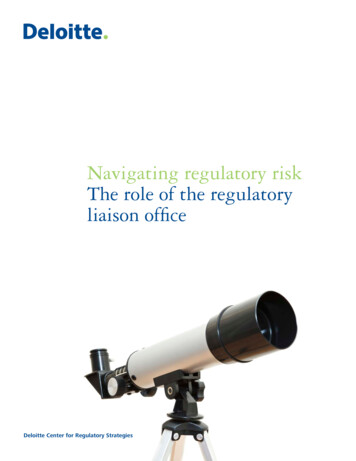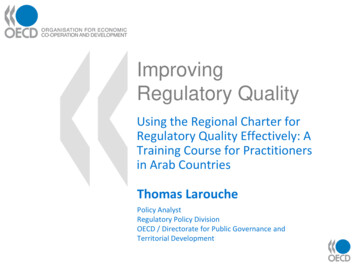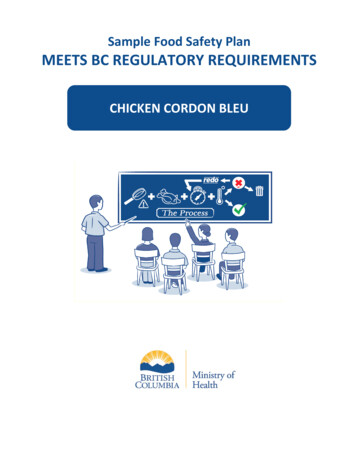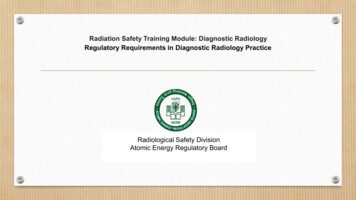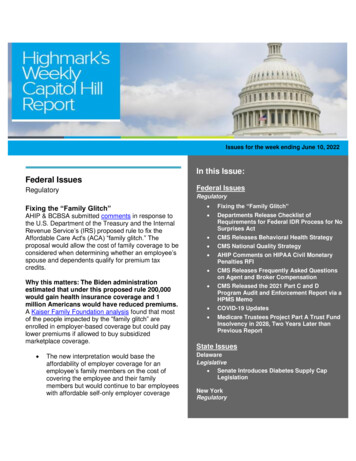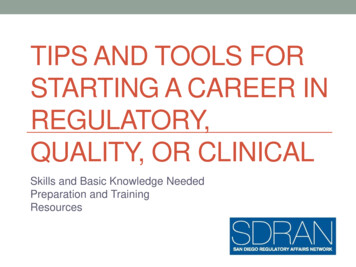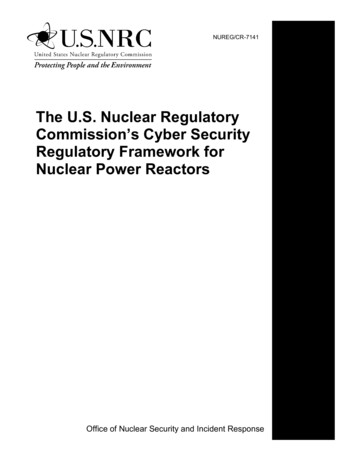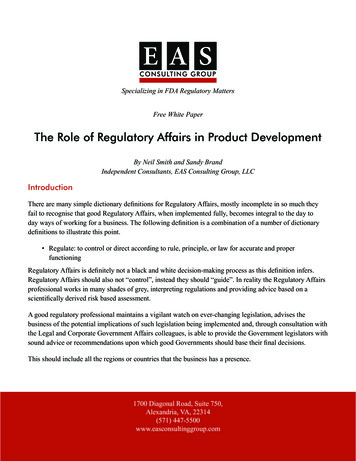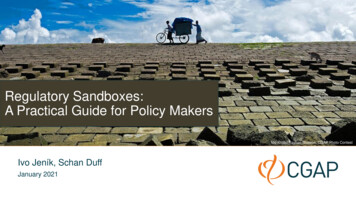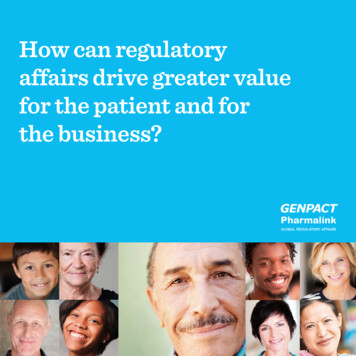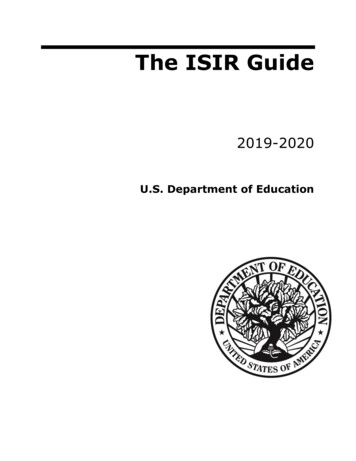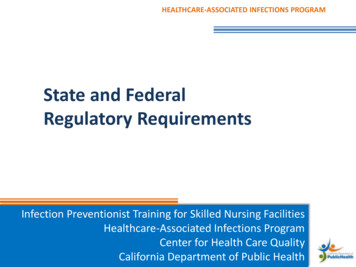
Transcription
HEALTHCARE-ASSOCIATED INFECTIONS PROGRAMState and FederalRegulatory RequirementsInfection Preventionist Training for Skilled Nursing FacilitiesHealthcare-Associated Infections ProgramCenter for Health Care QualityCalifornia Department of Public Health
HEALTHCARE-ASSOCIATED INFECTIONS PROGRAMObjectives Describe national, state, and local regulatory bodiesthat oversee infection prevention and HAI publicreporting Describe the purpose of CDPH All Facilities Letters(AFL) Review current infection control-related regulations2
HEALTHCARE-ASSOCIATED INFECTIONS PROGRAMHAI Public Reporting Policies Driven byCall for Transparency Disclosure to the public is intended as a driver for infectionprevention; encourages healthcare providers to take action Reporting publicly allows the consumer to assess quality ofhealthcare for each facility Informing the public can drive demand for higher qualityhealthcare Reporting HAIs became law for hospitals in 2006 & 2008 Requirement to report HAIs to CMS became law in 2014 forSNFsCMS SNF Quality Reporting Program Public g3
HEALTHCARE-ASSOCIATED INFECTIONS PROGRAMRegulatory Agency OverviewFederalStateLocalCenters for Medicare andMedicaid Services (CMS)California Department ofLocal health office andPublic Healthhealth department Licensing & Certification Reportable Diseases andconditions Medical WasteOccupational Health andSafety Administration(OSHA)Cal-OSHAEnvironmental HealthCommunicable Diseasereporting4
HEALTHCARE-ASSOCIATED INFECTIONS PROGRAMState Oversight:CDPH Licensing and Certification (L&C) Headquartered in Sacramento, CA 18 district offices 600 health facility evaluator nurses (HFEN) Licenses facilities to operate in California, including General acute care hospitals (GACH) Skilled nursing facilities (SNF)5
HEALTHCARE-ASSOCIATED INFECTIONS PROGRAMFederal Oversight: Centers for Medicare andMedicaid Services (CMS) Provision of health insurance through Medicare and Medicaid Surveys and certification health care facilities, including nursinghomes, home health agencies, and hospitals Requirement by Social Security Administration (SSA) to meetconditions of participation (CoP) by the facility, in order toreceive Medicare and Medicaid funds (SSA Section 1861)Electronic Code of Federal Regulations(www.ecfr.gov/cgi-bin/textidx?SID 7db07035274456a040371c5839d77a1d&mc true&tpl /ecfrbrowse/Title42/42tab 02.tpl)6
HEALTHCARE-ASSOCIATED INFECTIONS PROGRAMAccreditation Agencies Certifies compliance with CMS conditions of participation Private, independent accreditation organizations The Joint Commission (TJC) National Integrated Accreditation for HealthcareOrganizations (NIAHO; DNV Healthcare) Healthcare Facilities Accreditation Program (HFAP) No citations come from these directly Act as CMS surveyors Information from these surveyors is provided to CMS, whodetermines penalties7
HEALTHCARE-ASSOCIATED INFECTIONS PROGRAMAccreditation Agencies – AmbulatorySurgery Centers American Association of Ambulatory Surgery Centers(AAASC) American Association for Accreditation of AmbulatorySurgical Facilities (AAAASF) Accreditation Association for Ambulatory Health Care(AAAHC)8
HEALTHCARE-ASSOCIATED INFECTIONS PROGRAMRelationships The Joint Commission Certifies or “deems” to CMS thatfacilities licensed in California they have surveyed metfederal requirements Inspections by L&C reported to CMS via a contract with CMS Enforcement after L&C surveys of state laws (HSC 1188) andregulations (CCR Title 22) Surveys by Consolidated Accreditation and Licensing (CALS)conducted jointly with TJC9
HEALTHCARE-ASSOCIATED INFECTIONS PROGRAMGeneral Acute Care Relicensing Survey Purpose is to promote quality of care in hospitals, verifycompliance with state regulations and statutes, and ensurea program wide consistency in the hospital surveymethodology. Implemented March 2016 Survey every 3 years, 3-5 day survey Evaluates hospital’s compliance with statutory andregulatory requirements Surveyors will select patients from various service areas 6%-10% of the current inpatient census will beselected for record review (minimum of 30)CDPH General Acute Care Relicensing eralAcuteCareRelicensingSurvey.aspx)10
HEALTHCARE-ASSOCIATED INFECTIONS PROGRAMSkilled Nursing Facility Surveys Surveys of SNFS are conducted by CDPH at least every 6–16months Assess compliance with state and federal standards Focus on facilities with outbreaks SNF will be surveyed out of schedule, sooner than usual Complaints of abuse and infectious disease concerns SNF will be visited immediately Revisits by other agencies if high risk findings arereportedCDPH L&C s/Regulations.aspx)11
HEALTHCARE-ASSOCIATED INFECTIONS PROGRAMCalifornia Law and Regulations Terminology Bills are passed by California legislature If signed by governor, bill becomes a statute or law Laws related to health become part of the California Healthand Safety Code (HSC) Regulations are written by the appropriate State ExecutiveBranch, agency or department such as CDPH to: Carry out what a bill authorizes or directly requires a Statedepartment to do Clarify requirements of a bill (less common)12
HEALTHCARE-ASSOCIATED INFECTIONS PROGRAMCDPH All Facility Letters (AFL) Communicates with healthcare facilities about laws andregulations Sent to inform facilities of new requirement or technologies change of requirement in healthcare clarify an existing law/regulation Enforcement actions Scope of practice clarifications General information that affects health facility The absence of an AFL does not absolve a facility fromcomplying with the law13
HEALTHCARE-ASSOCIATED INFECTIONS PROGRAM14CDPH ations.aspx)
HEALTHCARE-ASSOCIATED INFECTIONS PROGRAMAntibiotic Stewardship (ABS) for SNF15 AFL 15-30: Requires adoption of ABS policy for each SNF SB 361 (oal.ca.gov/): Failure to comply will result in enforcementactions per HSC section 1423 Authority by HSC section 1275.4 ABS to align with the 7 Core Elements of Antibiotic Stewardship forNursing Homes:1.2.3.4.5.Leadership commitment – Safe antibiotic use supportAccountability – physician, nursing, or pharmacist leadsDrug expertise – pharmacist or consultant pharmacistsAction – at least one policy or procedure for antibiotic useTracking – at least one process measure of use or outcome fromantibiotic use6. Reporting – regular feedback on antibiotic use7. Education – resources to clinicians, nursing, residents, familiesCDC Nursing Homes and Assisted Living ic-stewardship.html)
HEALTHCARE-ASSOCIATED INFECTIONS PROGRAM16AFL 20-84 (SNF) Refers to AB 81, AB 2644 - CDPH incorporating Quality and AccountabilitySupplemental Payment (QASP) effective January 1, 2021 Incorporates infection prevention program and COVID-19 mitigationrequirements into QASP QASP assesses SNF quality and bases payment on quality measures Requires a full time Infection Preventionist Training requirements – minimum of 14 hours initial IP training Attend IP education – minimum of 10 hours annually Designated IP (or shared by 2 to cover full time) for each facility Describes the IP Program Functions Management, staff education, regulatory requirements,performance Improvement and committees, occupational health,IPC policies and protocolsAFL 20-84.aspx)
HEALTHCARE-ASSOCIATED INFECTIONS PROGRAMAFL 20-85 (SNF)Notifies SNF of AB 2644 requiring full time IP Requires full time IP Must be LVN or RN (may job share) Hours specified for IP LVN or RN hours cannot include hours spentin direct care services Provide annual training for HCP in the facility Reporting communicable diseases during a declared emergency Disease or suspect disease related death reported within 24 hours Refers to AFL 20-43.3 Daily Reporting requires data entry intoNHSNAFL 20-85.aspx)17
HEALTHCARE-ASSOCIATED INFECTIONS PROGRAMCalifornia Health and Safety Code (HSC) HAI requirements were passed as Senate Bills 739, 1058,158 and 1311 in 2006, 2008 and 2014, respectively HSC sections that contain HAI requirements: 1188.45–1188.95: reporting and preventionrequirements, including an antimicrobial stewardshipprogram 1255.8: MRSA patient testing 1279.7: Hand hygiene program, connector languageCalifornia laws and regulations:Office of Administrative Law(www.oal.ca.gov)Official CA Legislative Information(www.leginfo.ca.gov)18
HEALTHCARE-ASSOCIATED INFECTIONS PROGRAMCalifornia Title 22 Regulations Division 5 Licensing and Certification of Health Facilities Chapter 1 General Acute Care Hospital Article 7 Administration Chapter 2 Acute Psychiatric Hospital Chapter 3 Skilled Nursing Facilities Chapter 4 Intermediate Care Facilities Chapter 7 Primary Care Clinics Chapter 7.1 Specialty Clinics Article 6 Hemodialyzer Reuse Chapter 12 Correctional Treatment19
HEALTHCARE-ASSOCIATED INFECTIONS PROGRAMCalifornia Code of Regulations: Title 22* Requires a written infection control program for thesurveillance, prevention, and control of infections Covered by policies and procedures: Management of transmission risks Education Surveillance plan, including outbreak management Biohazardous equipment and materials identification Oversight of the program is part of a multidisciplinarycommittee Care of residents with infectious diseases *Title 22, Div 5, Chap 1, Article 7, Sec 70739 Title22, Div 5, Chap 3, Article 3, Sec 7232120
HEALTHCARE-ASSOCIATED INFECTIONS PROGRAMReportable Diseases and Conditions -Title 17 All cases of reportable diseases shall be reported to the localhealth officer Reportable conditions may vary by local health jurisdiction California Confidential Morbidity Report (CMR) form is usedto report all conditions except TB Consult with local health for their particular requirements,forms, method of reportingReporting of Communicable B0FB1711DEACA9F33E9EE53480?viewType FullText&originationContext documenttoc&transitionType CategoryPageItem&contextData (sc.Default)CDPH Reportable Disease and Conditions Morbidity Report ntrolledForms/cdph110a.pdf)21
HEALTHCARE-ASSOCIATED INFECTIONS PROGRAMCalifornia HAI Reporting Requirements Follow California acute care hospital requirements and NHSNrules for reporting healthcare associated infections (HAI) CLABSI – all in-patient hospital locations CLIP - for lines inserted in ICUs MRSA and VRE – all positive blood stream infections for allinpatients, ED and 24 hour observation units CDI – using LabID, all inpatient, ED and 24 hourobservation units SSI - for 28 procedure categories22
HEALTHCARE-ASSOCIATED INFECTIONS PROGRAMCal-OSHA Protection of the worker with guidance to keep workershealthy and safe in the state of California Department of Industrial Relations Division of Occupational Safety and Health Develops regulations for workplace safety and health Bloodborne Pathogen Standard Aerosol-Transmissible Diseases Standard Respiratory Protection Standard Regulations must be as stringent (or more) than federalregulationsCal/OSHA(www.dir.ca.gov/dosh/)23
HEALTHCARE-ASSOCIATED INFECTIONS PROGRAMCalifornia Medical Waste Management Act* Ensures proper handling and disposal of medical wastethroughout California Biohazardous wastea) Laboratory waste, including human or animal specimencultures from medical and pathology laboratoriesb) Human surgery specimens or tissuec) Waste containing discarded materials contaminatedwith excretion, exudate, or secretions fromhumans required to be isolated by infection controlstaff, attending physician and surgeon, or local healthofficer*Health and Safety Code 117600 and 11763524
HEALTHCARE-ASSOCIATED INFECTIONS PROGRAMFederal Regulations -CMS Title 42 Subchapter G Standards and Certification Part 482 Conditions of Participation For Hospitals Part 483 Requirements For States and LTC Part 484 Home Health Services Part 493 Laboratory Requirements Part 494 Conditions for Coverage for End-stage RenalDisease Facilities25
HEALTHCARE-ASSOCIATED INFECTIONS PROGRAMPart 42 Subpart C: Basic Hospital Functions§§§§482.21 Quality Assurance482.22 Medical Staff482.23 Nursing services482.24 Medical recordservices§ 482.25 Pharmaceuticalservices§ 482.26 Radiologicservices§ 482.27 Laboratoryservices§ 482.28 Food and Dieteticservices§ 482.31 Utilization review§ 482.41 Physicalenvironment§ 482.42 Infection Control§ 482.43 Dischargeplanning§ 482.45 Organ, tissue, andeye procurement26
HEALTHCARE-ASSOCIATED INFECTIONS PROGRAMPart 42 Subpart B: Requirements for LTCF§483.5 Definitions§483.10 Resident Rights§483.12 Freedom from Abuse,Neglect, and Exploitation§483.15 Admission Transfer andDischarge Rights§483.20 Resident Assessment§483.21 Comprehensive PersonCentered Care Plans§483.24 Quality of Life§483.25 Quality of Care§483.30 Physician Services§483.35 Nursing Services§483.40 Behavioral health services§483.45 Pharmacy Services§483.50 Laboratory Radiology andOther Diagnostic Services§483.55 Dental Services§483.60 Food and Nutrition Services§483.65 Specialized RehabilitativeServices§483.70 Administration§483.75 Quality Assurance andPerformance Improvement§483.80 Infection ControlF Tag 880 lives here§483.85 Compliance and EthicsProgram§483.90 Physical Environment§483.95 Training Requirements27
HEALTHCARE-ASSOCIATED INFECTIONS PROGRAMCMS Conditions of Participation (CoP) Interpretive Guidelines for Infection Control 28Develop and maintain Infection control programProvide a safe, sanitary environmentPrevent the development and transmission of communicable diseasesSurveillance must be systematic (i.e., infections must be logged)Support by leadership: Ensure problems identified by infection control are addressed Take responsibility for corrective action plans when problems areidentifiedCMS Nursing g-Homes)CMS Appendix A - Survey Protocol, Regulations and Interpretive Guidelines for Hospitals /Manuals/downloads/som107ap a hospitals.pdf)
HEALTHCARE-ASSOCIATED INFECTIONS PROGRAMFinding Federal RegulationsCenters for Medicare and Medicaid Services (CMS)(www.cms.gov)CMS Regulations & Guidance(www.cms.gov/home/regsguidance.asp)CMS Hospital enter?redirect /center/hospital.asp)CMS 1716-P LTC Prospective Payment – Proposed tions)CMS Conditions of Participations tion/CFCsAndCoPs/index?redirect /CFCsAndCoPs/06 Hospitals.asp)CMS Interpretive Guidelines (PDF) revised ance/Manuals/downloads/SOM107AP a hospitals.pdf)29
HEALTHCARE-ASSOCIATED INFECTIONS PROGRAMCurrent CMS NHSN Acute Care HospitalReporting RequirementsHAI Reporting Requirements to CMS via rements.pdf) January 2019)30
HEALTHCARE-ASSOCIATED INFECTIONS PROGRAMCurrent CMS NHSN LTAC ReportingRequirementsLTAC - Still required by CDPH to report MRSA and VREBacteremiaHAI Reporting Requirements to CMS via NHSN irements.pdf)31
HEALTHCARE-ASSOCIATED INFECTIONS PROGRAM32CMS Value-Based Purchasing Program Participating facilities in CMS quality/incentive reportingprograms are required to track and report HAI to NHSN; NHSNshares data with CMS Penalties from CMS to facilities who do not show improvementof healthcare acquired conditions Conditions include CLABSI, CDI, and CAUTI Up to 2% of Medicare claims dollars can be withheldCMS Value Based ms/HVBP/Hospital-Value-Based-Purchasing)SNF Value-Based Purchasing Program: FAQs st-2020.pdf)
HEALTHCARE-ASSOCIATED INFECTIONS PROGRAMSummary There are many mandates and influencers that affectinfection prevention practices The IP must be familiar and stay informed with mandatesand influencers to facilitate compliance in their facility33
HEALTHCARE-ASSOCIATED INFECTIONS PROGRAMQuestions?For more information,please contactHAIProgram@cdph.ca.govInclude “SNF IP TrainingClass” in the subject linePost TestNow that you havecompleted this module,Click on the “Post Test”link when it pops upTo Return toLearning Streamand take the post testIf the Post Test link does not pop up,you will be sent a link via e-mail34
National Integrated Accreditation for Healthcare Organizations (NIAHO; DNV Healthcare) Healthcare Facilities Accreditation Program ( HFAP) No citations come from these directly Act as CMS surveyors Information from these surveyors is provided to CMS, who
